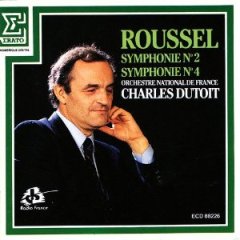Albert Roussel: Symphonies No. 2, Op. 23 & No. 4, Op. 53 [1987]
Albert Roussel: Symphonies No. 2, Op. 23 & No. 4, Op. 53 [1987]

1 Symphony No. 2, Op. 23 In B Flat Major: Lent 2 Symphony No. 2, Op. 23 In B Flat Major: Modere 3 Symphony No. 2, Op. 23 In B Flat Major: Tres lent 4 Symphony No. 4, Op. 53 In A Major: Lento 5 Symphony No. 4, Op. 53 In A Major: Lento molto 6 Symphony No. 4, Op. 53 In A Major: Allegro Scherzando 7 Symphony No. 4, Op. 53 In A Major: Allegro molto Orchestre National de France Charles Dutoit – conductor
Symphony No. 2 in B flat major, Op. 23 is a grand and brooding symphony whose tone is mostly one of striving. It is in three movements, each of which includes fast and slow music.
The first movement starts out slowly, gets faster, then slows down again. The densely-colored introduction introduces a tonal conflict between D major and the title key, B-flat. Eventually violins come in with the first theme of the fast part, which is later taken up by flute and oboe. Both the theme and its accompaniment are nervous and insistent. Horns and violas announce the more sunny and optimistic second theme, after which both themes are worked over in an atmosphere of striving and conflict. Material from the introduction intercedes, as if to halt progress, and things slow down on the way to the conclusion, which, like the introduction, is in B-flat and D.
The second movement starts out fast, with woodwinds prominent. Shortly after the beginning the violins give out a gamboling theme over piquant harmonies and colors. Sometimes the gamboling becomes heavy-footed, informed by Roussel's characteristic gruffness. The coloristic felicities are too numerous to mention, although a high clarinet line over lusty horn parts seems noteworthy. The middle section is slower, and more reflective. A tad disturbed at first, it eventually works up to the striving mood of the first movement. The first part abrubtly dismisses the concerns of the middle section when it returns in a varied recapitulation.
The third movement starts out slowly, and returns to the striving tone and thematic materials of the first movement. The harmony eventually stabilizes into B-flat, resolving the tonal conflict if not the dramatic one. We may not be victorious, but we are at rest. ---Aaron Rabushka, Rovi
Written by the sick and tired 65-year-old composer in a single three-and-a-half-month period in the fall of 1934, Albert Roussel's Symphony No. 4 was nevertheless one of the most vigorous and optimistic symphonic works of the 1935 season. Written in the traditional four movements and in the conservative harmonic language of la belle époque expressed in the severe counterpoint of the Schola Cantorium, Roussel's Fourth is still an extremely powerful and affecting work imbued with sincerity, strength, nobility, and a very, very dry wit. After a radiantly glowering Lento introduction, the opening Allegro con brio in sonata form never varies its pulse as it builds to an abrupt coda. The Lento molto may be the most expressive music Roussel ever wrote, solemn but emotionally searing music of uncommon power and sincerity. The Allegro scherzando is a muscular jig with just the slightest trace of irony. The closing Allegro molto is also in sonata form, but a sonata form permeated by a concentrated wit and a joyful counterpoint culminating in a magnificent coda. ---James Leonard, Rovi
download: uploaded yandex 4shared mediafire solidfiles mega zalivalka filecloudio anonfiles oboom ziddu
Last Updated (Sunday, 27 April 2014 20:18)
